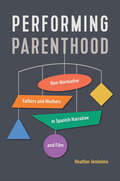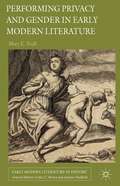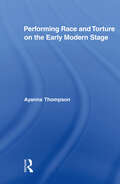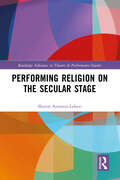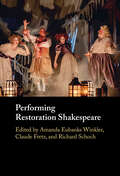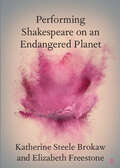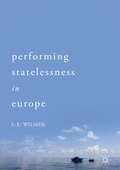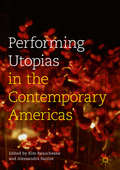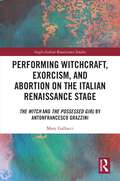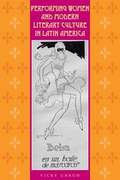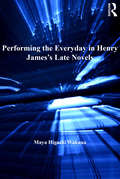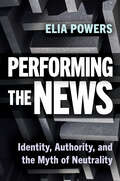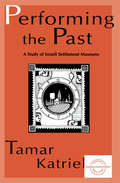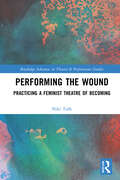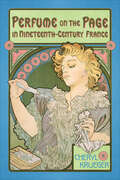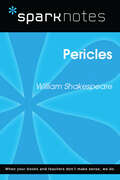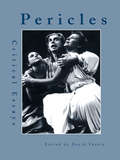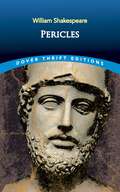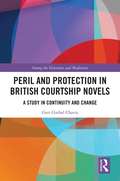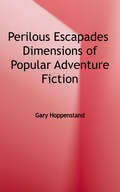- Table View
- List View
Performing Oaths in Classical Greek Drama
by Judith FletcherOaths were ubiquitous rituals in ancient Athenian legal, commercial, civic and international spheres. Their importance is reflected by the fact that much of surviving Greek drama features a formal oath sworn before the audience. This is the first comprehensive study of that phenomenon. The book explores how the oath can mark or structure a dramatic plot, at times compelling characters like Euripides' Hippolytus to act contrary to their best interests. It demonstrates how dramatic oaths resonate with oath rituals familiar to the Athenian audiences. Aristophanes' Lysistrata and her accomplices, for example, swear an oath that blends protocols of international treaties with priestesses' vows of sexual abstinence. By employing the principles of speech act theory, this book examines how the performative power of the dramatic oath can mirror the status quo, but also disturb categories of gender, social status and civic identity in ways that redistribute and confound social authority.
Performing Parenthood: Non-Normative Fathers and Mothers in Spanish Narrative and Film (Toronto Iberic #92)
by Heather JerónimoPerforming Parenthood reveals different enactments of motherhood and fatherhood in twentieth- and twenty-first-century Spain, showing how the family has adapted, or at times failed to do so, within the context of Spain’s changing socioeconomic reality. Through an examination of examples of non-normative parenthood in contemporary Spanish literature and film – including gay literary father figures, subversive physical touch between mother and child, fathers who cross-dress, lesbian maternal community building, non-biological parenting, and disabled bodies – the book argues that current conceptualizations of parenthood should be amplified to reflect the various existing identities and performances of motherhoods and fatherhoods. Connecting canonical works to recent works, the book establishes a unique dialogue that will expand the conversation about the Spanish family beyond the traditional view, bringing visibility to alternative family models. It argues that parental identities exist on a spectrum, enabling many parental figures to disregard heteronormative standards imposed upon the role and allowing them to experience parenthood in meaningful ways. Bringing visibility to literary and cinematic examples of alternative Spanish families, Performing Parenthood provides a glimpse into an evolving society influenced by national and global changes.
Performing Privacy and Gender in Early Modern Literature
by Mary E. TrullThis book argues that the early modern public/private boundary was surprisingly dynamic and flexible in early modern literature, drawing upon authors including Shakespeare, Anne Lock, Mary Wroth, and Aphra Behn, and genres including lyric poetry, drama, prose fiction, and household orders. An epilogue discusses postmodern privacy in digital media.
Performing Public History: Case Studies in Historical Storytelling (Global Perspectives on Public History)
by David DeanPerforming Public History explores history-telling as a performance across a wide range of media, including theatre and film, historical re-enactments and living history performances, operas, and video games.Taking historians as storytellers, this book illustrates how the choices they make shape historical meaning. While historians may strive to be objective when they research and write the past, they inevitably draw on their imagination, emotions, and creativity, aligning them with others who make history in public. The book explores issues such as the nature of archives, realism, fact and fiction, accuracy and authenticity, and actants and audiences. It draws on case studies from all parts of the world, offering global perspectives that invite a rethinking about what history is, and how and why we do it. Sharing work by graduate students, the author also offers an appendix of classroom exercises that instructors will find valuable.Written accessibly for students, this volume offers a succinct account of the discipline of history, the field of public history, and how performance is a useful concept for thinking about history work.
Performing Race and Torture on the Early Modern Stage (Routledge Studies in Renaissance Literature and Culture #9)
by Ayanna ThompsonPerforming Race and Torture on the Early Modern Stage provides the first sustained reading of Restoration plays through a performance theory lens. This approach shows that an analysis of the conjoined performances of torture and race not only reveals the early modern interest in the nature of racial identity, but also how race was initially coded in a paradoxical fashion as both essentially fixed and socially constructed. An examination of scenes of torture provides the most effective way to unearth these seemingly contradictory representations of race because depictions of torture often interrogate the incongruous desire to substitute the visible and manipulable materiality of the body for the more illusive performative nature of identity. In turn, Performing Race and Torture on the Early Modern Stage challenges the long-standing assumption that early modern conceptions of race were radically different in their fluidity from post-Enlightenment ones by demonstrating how many of the debates we continue to have about the nature of racial identity were engendered by these seventeenth-century performances.
Performing Religion on the Secular Stage (Routledge Advances in Theatre & Performance Studies)
by Sharon Aronson-LehaviThis book examines the relations between Western religion, secularism, and modern theater and performance. Sharon Aronson-Lehavi posits that the ongoing cultural power of religious texts, icons, and ideas on the one hand and the artistic freedom enabled by secularism and avant-garde experimentalism on the other, has led theatre artists throughout the twentieth century to create a uniquely modern theatrical hybrid–theater performances that simultaneously re-inscribe and grapple with religion and religious performativity. The book compares this phenomenon with medieval forms of religious theater and offers deep and original analyses of significant contemporary works ranging from plays and performances by August Strindberg, Hugo Ball (Dada), Jerzy Grotowski, and Hanoch Levin, to those created by Adrienne Kennedy, Rina Yerushalmi, Deb Margolin, Milo Rau, and Sarah Ruhl. The book analyzes a new and original historiography of a uniquely modern theatrical phenomenon, a study that is of high importance considering the reemergence of religion in contemporary culture and politics.
Performing Restoration Shakespeare
by Richard Schoch Amanda Eubanks Winkler Claude FretzPerforming Restoration Shakespeare embraces the performative and musical qualities of Restoration Shakespeare (1660–1714), drawing on the expertise of theatre historians, musicologists, literary critics, and - importantly - theatre and music practitioners. The volume advances methodological debates in theatre studies and musicology by advocating an alternative to performance practices aimed at reviving 'original' styles or conventions, adopting a dialectical process that situates past performances within their historical and aesthetic contexts, and then using that understanding to transform them into new performances for new audiences. By deploying these methodologies, the volume invites scholars from different disciplines to understand Restoration Shakespeare on its own terms, discarding inhibiting preconceptions that Restoration Shakespeare debased Shakespeare's precursor texts. It also equips scholars and practitioners in theatre and music with new - and much needed - methods for studying and reviving past performances of any kind, not just Shakespearean ones.
Performing Shakespeare on an Endangered Planet (Elements in Shakespeare Performance)
by Katherine Steele Brokaw Elizabeth FreestoneGiven the many environmental crises facing the planet, we need to use all tools to address them, including Shakespearean theatre. This Element explains why Shakespeare is well-positioned to be an eco-playwright, how theatre-makers can adapt his plays to matter now, and how to make more ecological the many processes of Shakespearean theatre, from set design to performing outdoors. The co-authors are both directors, and conversations between them about their recent eco-productions of The Tempest for the Royal Shakespeare Company and A Midsummer Night's Dream for Shakespeare in Yosemite (California) give clear examples of both the why and how of eco-theatrical Shakespeare.
Performing Statelessness in Europe
by S. E. WilmerThis book examines performative strategies that contest nationalist prejudices in representing the conditions of refugees, the stateless and the dispossessed. In the light of the European Union failing to find a political solution to the current migration crisis, it considers a variety of artistic works that have challenged the deficiencies in governmental and transnational practices, as well as innovative efforts by migrants and their hosts to imagine and build a new future. It discusses a diverse range of performative strategies, moving from a consideration of recent adaptations of Greek tragedy, to performances employing fictive identification, documentary dramas, immersive theatre, over-identification and subversive identification, nomadism and political activism. This study will appeal to those interested in questions of statelessness, migration, and the problematic role of the nation-state.
Performing Utopias in the Contemporary Americas
by Kim Beauchesne Alessandra SantosThis book offers an innovative examination of the utopian impulse through performance as a proposition of practical engagement in the contemporary Americas. The volume compiles unique multidisciplinary and exploratory texts, applying diverse critical and artistic approaches. Its contributors reconceptualize utopia as a creative and theoretical method based on a commitment to sociopolitical transformation. Chapters are organized around notions of mapping utopias, indigenizing practices, political manifestations, and the construction of social identities.
Performing Witchcraft, Exorcism, and Abortion on the Italian Renaissance Stage: The Witch and The Possessed Girl by Antonfrancesco Grazzini (Anglo-Italian Renaissance Studies)
by Mary GallucciAntonfrancesco Grazzini’s plays, La Spiritata (The Possessed Girl) and La Strega (The Witch), are available in English for the first time, with notes and an “Introduction.” These plays deal with witchcraft, superstition, sexuality, and abortion. The context for such themes is analyzed in the “Introduction.” Grazzini enhanced literary drama with elements from popular performances. He influenced other playwrights, including in England, where The Possessed Girl was adapted as the Elizabethan comedy, The Bugbears. Writer and linguist John Florio used Grazzini’s plays in his lexicon of Italian for English learners. Grazzini celebrated artistic and popular traditions of Renaissance Florence; he is significant for writing and preserving many literary genres, especially the burlesque and carnivalesque. He participated in Florentine spectacle and theater, as a writer of plays, a composer of interludes, and a chronicler of festive events. His importance to the development of the Italian language is evident in his plays.
Performing Women and Modern Literary Culture in Latin America: Intervening Acts
by Vicky UnruhWomen have always been the muses who inspire the creativity of men, but how do women become the creators of art themselves? This was the challenge faced by Latin American women who aspired to write in the 1920s and 1930s. Though women's roles were opening up during this time, women writers were not automatically welcomed by the Latin American literary avant-gardes, whose male members viewed women's participation in tertulias (literary gatherings) and publications as uncommon and even forbidding. How did Latin American women writers, celebrated by male writers as the "New Eve" but distrusted as fellow creators, find their intellectual homes and fashion their artistic missions?
Performing the Everyday in Henry James's Late Novels
by Maya Higashi WakanaFocusing on James's last three completed novels - The Ambassadors, The Wings of the Dove, and The Golden Bowl - Maya Higashi Wakana shows how a microsociological approach to James's novels radically revises the widespread tradition of putting James's characters into historical and cultural contexts. Wakana begins with the premise that day-to-day living is inherently theatrical and thus duplicitous, and goes on to show that James's art relies significantly on his powerful sense of the agonizing and even dangerous complications of mundane face-to-face rituals that pervade his work. Centrally informed by social thinkers such as G. H. Mead and Erving Goffman, Wakana's study discloses the richness, complexity, and singularity of the interpersonal connections depicted in James's late novels. Persuasively argued, and rich in original close readings, her book makes an important contribution to James's studies and to theories of social interaction.
Performing the News: Identity, Authority, and the Myth of Neutrality
by Elia PowersPerforming the News: Identity, Authority, and the Myth of Neutrality explores how journalists from historically marginalized groups have long felt pressure to conform when performing for audiences. Many speak with a flat, “neutral” accent, modify their delivery to hide distinctive vocal attributes, dress conventionally to appeal to the “average” viewer, and maintain a consistent appearance to avoid unwanted attention. Their aim is what author Elia Powers refers to as performance neutrality—presentation that is deemed unobjectionable, reveals little about journalists’ social identity, and supposedly does not detract from their message. Increasingly, journalists are challenging restrictive, purportedly neutral forms of self-presentation. This book argues that performance neutrality is a myth that reinforces the status quo, limits on-air diversity, and hinders efforts to make newsrooms more inclusive. Through in-depth interviews with journalists in broadcasting and podcasting, and those who shape their performance, the author suggests ways to make journalism more inclusive and representative of diverse audiences.
Performing the Past: A Study of Israeli Settlement Museums (Everyday Communication Series)
by Tamar KatrielA nostalgic interest in the past is a well-recognized feature of fast-changing, contemporary societies. It finds its expression in a variety of history-making practices of which the establishment of local heritage museums is a major manifestation in many parts of the world today. Katriel develops a communication-centered perspective on the study of heritage museums and -- by extension -- other tourist sites, highlighting the role of discourse in these institutionalized, yet vernacular contexts of cultural production, social legitimation, and identity formation. Descriptive and critical in orientation, this book combines a close analysis of museum discourse with an exploration of such larger issues as: * the socio-cultural role of museums as arenas for the production of collective memory, * the ideological and performative constraints that shape museum presentations, * the interfacing of verbal and visual codes of communication in the context of material displays, * the dialectical interplay of the local and the global in contemporary life, and * the interpenetration of the personal and the communal in vernacular processes of narrative production. Of interest to scholars in communication, linguistics, anthropology, history, museum studies, tourism, intercultural communication, middle eastern studies, or those with interests in narratives, material culture, and ethnography.
Performing the Politics of Translation in Modern Japan: Staging the Resistance (Routledge Studies in the Modern History of Asia)
by Aragorn QuinnPerforming the Politics of Translation in Modern Japan sheds new light on the adoption of concepts that motivated political theatres of resistance for nearly a century and even now underpin the collective understanding of the Japanese nation. Grounded in the aftermath of the Meiji Restoration in 1868 and analyzing its legacy on stage, this book tells the story of the crucial role that performance and specifically embodied memory played in the changing understanding of the imported Western concepts of "liberty" (jiyū) and "revolution" (kakumei). Tracing the role of the post-Restoration movement itself as an important touchstone for later performances, it examines two key moments of political crisis. The first of these is the Proletarian Theatre Movement of the 1920s and '30s, in which the post-Restoration years were important for theorizing the Japanese communist revolution. The second is in the postwar years when Rights Movement theatre and thought again featured as a vehicle for understanding the present through the past. As such, this book presents the translation of "liberty" and "revolution", not through a one-to-one correspondence model, but rather as a many-to-many relationship. In doing so, it presents a century of evolution in the dramaturgy of resistance in Japan. This book will be useful to students and scholars of Japanese history, society and culture, as well as literature and translation studies alike.
Performing the Socialist State: Modern Chinese Theater and Film Culture
by Xiaomei ChenPerforming the Socialist State offers an innovative account of the origins, evolution, and legacies of key trends in twentieth-century Chinese theater. Instead of seeing the Republican, high socialist, and postsocialist periods as radically distinct, it identifies key continuities in theatrical practices and shared aspirations for the social role and artistic achievements of performance across eras.Xiaomei Chen focuses on the long and remarkable careers of three founders of modern Chinese theater and film, Tian Han, Hong Shen, and Ouyang Yuqian, and their legacy, which helped shape theater cultures into the twenty-first century. They introduced Western plays and theories, adapted traditional Chinese operas, and helped develop a tradition of leftist theater in the Republican period that paved the way for the construction of a socialist canon after 1949. Chen investigates how their visions for a free, democratic China fared in the initial years after the founding of the People’s Republic, briefly thriving only to founder as artists had to adapt to the Communist Party’s demand to produce ideologically correct works. Bridging the faith play and “antiparty plays” of the 1950s, the “red classics” of the 1960s, and their reincarnations in the postsocialist period, she considers the transformations of the depictions of women, peasants, soldiers, scientists, and revolutionary history in plays, operas, and films and examines how the market economy, collective memories, star culture, social networks, and state sponsorship affected dramatic productions.Countering the view that state interference stifles artistic imagination, Chen argues that theater professionals have skillfully navigated shifting ruling ideologies to create works that are politically acceptable yet aesthetically ingenious. Emphasizing the power, dynamics, and complexities of Chinese performance cultures, Performing the Socialist State has implications spanning global theater, comparative literature, political and social histories, and Chinese cultural studies.
Performing the Wound: Practicing a Feminist Theatre of Becoming (Routledge Advances in Theatre & Performance Studies)
by Niki TulkThis book offers a matrixial, feminist-centered analysis of trauma and performance, through examining the work of three artists: Ann Hamilton, Renée Green, and Cecilia Vicuña. Each artist engages in a multi-media, or “combination” performance practice; this includes the use of site, embodied performance, material elements, film, and writing. Each case study involves traumatic content, including the legacy of slavery, child sexual abuse and environmental degradation; each artist constructs an aesthetic milieu that invites rather than immerses—this allows an audience to have agency, as well as multiple pathways into their engagement with the art. The author Niki Tulk suggests that these works facilitate an audience-performance relationship based on the concept of ethical witnessing/wit(h)nessing, in which viewers are not positioned as voyeurs, nor made to risk re-traumatization by being forced to view traumatic events re-played on stage. This approach also allows agency to the art itself, in that an ethical space is created where the art is not objectified or looked at—but joined with. Foundational to this investigation are the writings of Bracha L. Ettinger, Jill Bennett and Diana Taylor—particularly Ettinger’s concepts of the matrixial, carriance and border-linking. These artists and scholars present a capacity to expand and articulate answers to questions regarding how to make performance that remains compelling and truthful to the trauma experience, but not re-traumatizing. This study will be of great interest to students and scholars of performance studies, art history, visual arts, feminist studies, theatre, film, performance art, postcolonialism, rhetoric and writing.
Perfume on the Page in Nineteenth-Century France (University of Toronto Romance Series)
by Cheryl KruegerDespite long-standing assertions that languages, including French and English, cannot sufficiently communicate the experience of smell, much of France’s nineteenth-century literature has gained praise for its memorable evocation of odours. As French perfume was industrialized, democratized, cosmeticized, and feminized in the nineteenth century, stories of fragrant scent trails aligned perfume with toxic behaviour and viewed a woman’s scent as something alluring, but also something to be controlled. Drawing on a wealth of resources, Perfume on the Page in Nineteenth-Century France explores how fiction and related writing on olfaction meet, permeate, and illuminate one another. The book examines medical tracts, letters, manuscripts, posters, print advertisements, magazine articles, perfume manuals, etiquette books, interviews, and encounters with fragrant materials themselves. Cheryl Krueger explores how the olfactory language of a novel or poem conveys the distinctiveness of a text, its unique relationship to language, its style, and its ways of engaging the reader: its signature scent. Shedding light on the French perfume culture that we know today, Perfume on the Page in Nineteenth-Century France follows the scent trails that ultimately challenge us to read perfume and literature in new ways.
Pericles (SparkNotes Literature Guide Series)
by SparkNotesPericles (SparkNotes Literature Guide) by William Shakespeare Making the reading experience fun! Created by Harvard students for students everywhere, SparkNotes is a new breed of study guide: smarter, better, faster. Geared to what today's students need to know, SparkNotes provides: *Chapter-by-chapter analysis *Explanations of key themes, motifs, and symbols *A review quiz and essay topicsLively and accessible, these guides are perfect for late-night studying and writing papers
Pericles: Critical Essays (Shakespeare Criticism #Vol. 23)
by David SkeelePericles: Critical Essays brings together the most essential critical essays and theatrical reviews of Shakespeare's play from the late 17th century to the present, providing a representative gathering of critical opinion of Pericles over the centuries. David Skeele's introduction identifies the critical issues and problems the play has raised, cites and evaluates significant critical works, and gives readers a guide to research on the play.
Pericles: With The Story Of The Prince Of Tyre... . (Dover Thrift Editions)
by William ShakespeareThis romantic drama portrays the travails of a wandering prince and the redemptive powers of a daughter's love. Driven from one end of the Mediterranean to another by the winds of fate, Pericles endures loss and heartbreak before his odyssey ends in a miraculous reunion. Shipwreck, famine, and other disasters punctuate this wondrous tale, in which a knight in rusty armor fights for his true love and a princess kidnapped by pirates retains her honor by setting a virtuous example for her captors.Prologues delivered in the character of medieval English poet John Gower introduce each act of this unusual play, whose authorship has long been disputed. Written late in Shakespeare's career, Pericles was enormously popular in the seventeenth century and was the first of the playwright's dramas to be staged after the Restoration. The play fell into neglect until recent years, and now its charms are being rediscovered by modern audiences.
Pericles: With The Story Of The Prince Of Tyre... . (The Pelican Shakespeare)
by William ShakespeareThe acclaimed Pelican Shakespeare series edited by A. R. Braunmuller and Stephen Orgel The legendary Pelican Shakespeare series features authoritative and meticulously researched texts paired with scholarship by renowned Shakespeareans. Each book includes an essay on the theatrical world of Shakespeare’s time, an introduction to the individual play, and a detailed note on the text used. Updated by general editors Stephen Orgel and A. R. Braunmuller, these easy-to-read editions incorporate over thirty years of Shakespeare scholarship undertaken since the original series, edited by Alfred Harbage, appeared between 1956 and 1967. With definitive texts and illuminating essays, the Pelican Shakespeare will remain a valued resource for students, teachers, and theater professionals for many years to come. For more than seventy years, Penguin has been the leading publisher of classic literature in the English-speaking world. With more than 1,700 titles, Penguin Classics represents a global bookshelf of the best works throughout history and across genres and disciplines. Readers trust the series to provide authoritative texts enhanced by introductions and notes by distinguished scholars and contemporary authors, as well as up-to-date translations by award-winning translators.
Peril and Protection in British Courtship Novels: A Study in Continuity and Change (Among the Victorians and Modernists)
by Geri Giebel ChavisPeril and Protection in British Courtship Novels: A Study in Continuity and Change explores the use and context of danger/safety language in British courtship novels published between 1719 and 1920. The term "courtship novel" encompasses works focusing on both female and male protagonists’ journeys toward marriage, as well as those reflecting the intertwined nature of comic courtship and tragic seduction scenarios. Through careful tracking of peril and protection terms and imagery within the works of widely-read, influential authors, Professor Chavis provides a fresh view of the complex ways that the British novel has both maintained the status quo and embodied cultural change. Lucid discussions of each novel, arranged in chronological order, shed new light on major characters’ preoccupations, values, internal struggles, and inter-actional styles and demonstrate the ways in which gender ideology and social norms governing male-female relationships were not only perpetuated but also challenged and satirized during the course of the British novel’s development. Blending close textual analysis with historical/cultural and feminist criticism, this multi-faceted study invites readers to look with both a microscopic lens at the nuances of figurative and literal language and a telescopic lens at the ways in which modifications to views of masculinity and femininity and interactions within the courtship arena inform the novel genre’s evolution.
Perilous Escapades: Dimensions of Popular Adventure Fiction
by Gary HoppenstandAdventure fiction is one of the easiest narrative forms to recognize but one of the hardest to define because of its overlap with many other genres. This collection of essays attempts to characterize adventure fiction through the exploration of key elements--such as larger-than-life characters and imperialistic ideas--in the genre's 19th- and 20th-century British and American works like The Scarlet Pimpernel by Orczy and Captain Blood by Sabatini. The author explores the cultural and literary impact of such works, presenting forgotten classics in a new light.

